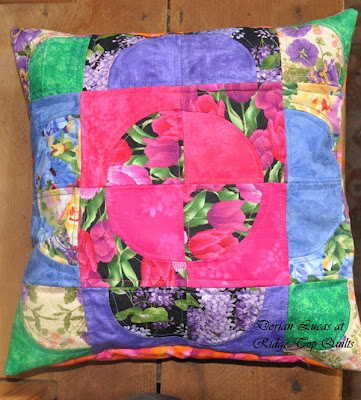This is the same pattern I used for my Spring table runner for my friend Carol.
Lots of patterns are easy to do in this manner. Just piece together the smaller parts, till you have rows, then quilt as you piece the rows onto the backing/batting.
I used a charm package of Fandango. This pattern uses all but 10 squares. I didn't want it any longer/bigger. And I *was* going to put the extra blocks on the back, in a pieced backing...and I forgot!
You will need:
1 charm pack or thirty-two 5" squares
17"x36" backing and batting
binding
The first thing to do is figure out your layout, what colors you want to make into HST's and where you want them. I drew a chart.
Here is what I used (the colors refer to the background of the prints):
2 brown blocks
2 yellow blocks
8 red blocks
8 white blocks
12 green blocks
To make the HST's. Match two squares, right sides together. Draw a line diagonally from one corner to another. And sew 1/4" on BOTH sides of it.
You will need to match:
2 brown squares to 2 green squares = 4 B/G HST's
2 yellow squares to 2 green squares = 4 Y/G HST's
4 red squares to 4 green squares = 8 R/G HST's
4 white squares to 4 green squares = 8 W/G HST's
Leave 4 red and 4 white squares whole for the center.
Chain piece your HST's
Lay out all your squares so they match your drawing of where you want them placed. Watching the HST's, so that they are how you want them. My green makes a nice little zig zag around the inner blocks.
Then you want to sew each piece of a row together. Starting at the left is row 1, then towards 8 at the right.
Now you have 8 rows, that look like this. Press your seams down on row 1, up on 2, down on 3, etc.
I laid mine all out like this, then put them in a stack with row 1 on the top. If you have more space, you can leave them laid out how they go, so you don't get them confused when sewing.
Next, take your back fabric and lay it right side down somewhere flat. I choose this fabric. The color is almost the same reddish-orangey in the Fandango line. And it also already has stabilizer ironed on it. So I didn't have to mess with any batting.
Lay your batting on top of your backing, smoothing them both out. If you use spray adhesive stuff, now would be a good time to use it, I think (I've never used it myself).
Lay row one face UP on your backing. The backing size is slightly larger than the table runner will be. So you don't have to line it up with the left side edge. You can leave a little bit of room for movement. Smooth it down, so there is no puckers or anything.
Lay row two face DOWN on top of row one. The seams should be opposite, so they snuggle together. PIN (I had to use more pins than is shown, as these HST's are a bit stretchy).
Now sew your seam, you'll be sewing right onto the backing/batting, so make sure your bottom thread is the color you want to show on the back.
Open up row two and smooth it out.
Continue until you've sewn on all 8 rows. Making sure each row is smooth and lump free, before adding the next one.
Now trim and put your binding on!
And you're all done!
The back is just 6 rows of stitching.
Thanks for stopping by.
Dorian
Copyright D. Lucas, 2011 This is my tutorial. You are welcome to use any of my tutorials for personal use. You are not permitted to use my pictures or my words without linking back to the original and giving me credit for them.





































